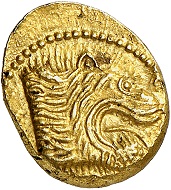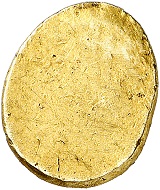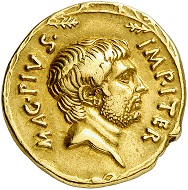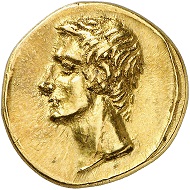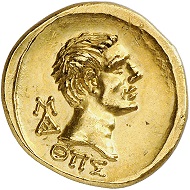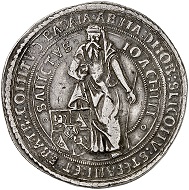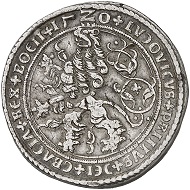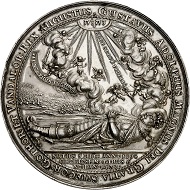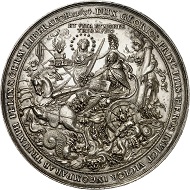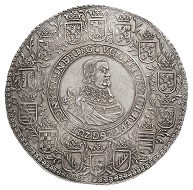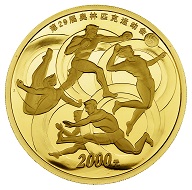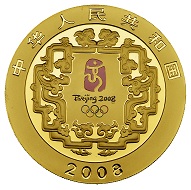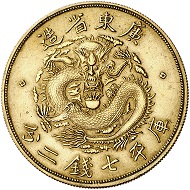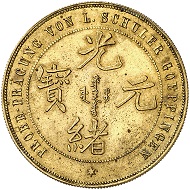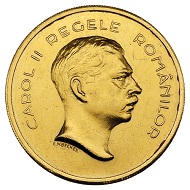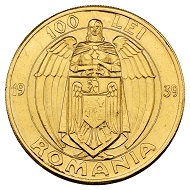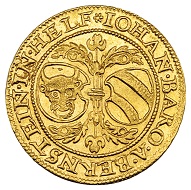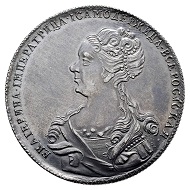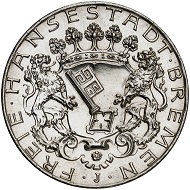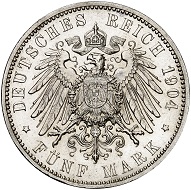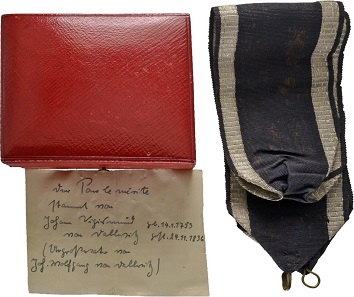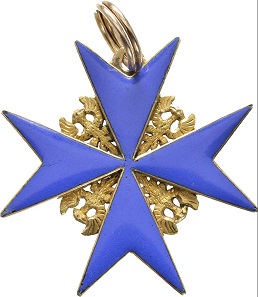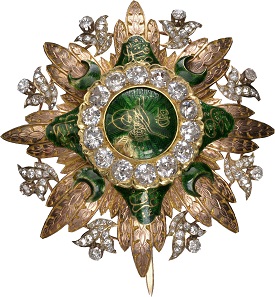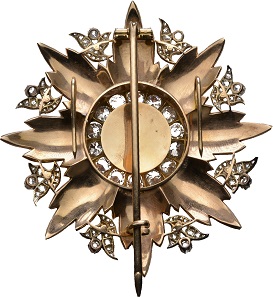24-09-2017 – 28-09-2017
Auctions 295-299
Outstanding Collections in the Künker Fall Auctions
On September 25 to 29, 2017, auction house Künker will auction 5,800 lots with a total estimate of nearly 7.5 million euros at the Steigenberger Hotel Remarque. The broad range of offers includes something for every taste.
The auction week will kick off with sale 295, comprising a wide choice of ancient coins. Above all, the Tetzlaff-Gahrmann Collection of Etruscan coins stands out. Auction 296, to be held on Tuesday, will offer coins and medals from Germany as well as world coins. Among other things, the Stricker Collection with strikings of the 30 Years’ War will be liquidated. On Wednesday, all eyes will be on the 1,000 lots stemming from the Opitz Collection. They are all related to the Reformation. On Thursday, gold coins and medals will cross the auction block, including rarities from the comprehensive Phoibos Collection. Furthermore, collectors can look forward to a large selection of modern Chinese strikings and Russian coins and medals. On Friday morning, post-1871 German coins will be offered for sale, including great rarities. And in the afternoon, sale 299 featuring orders and decorations will conclude the auction week. Amongst others, the Ottoman Collection with Turkish decorations will come under the hammer.
Lot 86: Populonia (Etruscans). AV-50 asses, 300-250 BC. From Hess-Leu sale 1 (1954), No. 19. From the Tetzlaff-Gahrmann Collection. Rare. Extremely fine. Estimate: 5,000,- euros.
Auction 295: Coins from the ancient world
Monday, September 25, 2017
Auction 295 featuring coins from the ancient world will be dominated by the Etruscans. The Dr. Rolf Tetzlaff-Gahrmann Collection, a world-class assemblage, will be auctioned. Over the course of half a century, Dr. Tetzlaff-Gahrmann collected 86 bronze, silver and gold coins of the Etruscan cities. Selected pieces from his collection formed part of the major exhibition on the Etruscans in Munich in 2015. Now, all of these coins return into the numismatic cycle, to become an asset to other collections.
Coins from all others areas of ancient coinage will of course also be sold. This is a short overview:
- Celts: 1-60
- Greeks: 61-498
- Romans, Republic and Imperators: 464-627
- Romans, Imperial Times: 628-1210
- Migration Period: 1211-1245
- Byzantium: 1246-1281
- Crusaders: 1282-1335
Lot 615: Sextus Pompey, +35 BC, with Pompey the Great and Gnaeus Pompeius. Aureus, 37-36 BC, Sicilian mint. Very rare. Very fine. Estimate: 75,000,- euros.
The collectors of Roman aurei in particular can look forward to an exquisite selection. The range covers a very fine aureus of Sextus Pompey with the portraits of his father and his brother on the reverse (estimate: 75,000 euros), a restitution(!) aureus of Trajan for Titus (estimate: 40,000 euros), to some very rare pieces dating from the Gallic Empire, including an extremely rare aureus of Tetricus I graded extremely fine (estimate: 50,000 euros).
Lot 661: Polemon I of Bosporus for Augustus. Gold stater, year 289 (= 9/8 BC). From the collection of Grand Duke Alexander Mikhailovich Romanov. Extremely rare. Almost FDC showpiece. Estimate: 60,000,- euros.
But also other rarities can be discovered. We restrict ourselves to the following pieces:
- A perfect gold stater of Polemon I of Bosporus, minted in 9/8 BC for Augustus and Agrippa. The showpiece in FDC once formed part of the collection of Grand Duke Alexander Mikhailovich Romanov (estimate: 60,000 euros).
- An almost extremely fine sestertius of Nero, the reverse featuring the popular depiction of the Port of Ostia. It stems from the 1993 Leu sale 57.
- A perfect cistophorus of Hadrian, with the Temple of Roma and Augustus on the reverse. It was the cover piece of the 1977 Leu sale 18.
- A 268 gold medallion of Claudius II Gothicus stemming from the 1974 Gitta Kastner sale 6.
- And last but not least an almost extremely fine siliqua of Sebastianus, struck in Arelate in 412/413.
Lot 1938: Schlick. Stephan Burian, Heinrich, Hieronymus, and Lorenz, 1505-1532. Double taler 1520, Joachimstal, with the title of Ludwig II, King of Hungary and Bohemia. Extremely rare. Very fine. Estimate: 20,000,- euros.
Auction 296: Coins and medals from medieval and modern times
Tuesday, September 26, 2017
World coins and medals with a focus on the Holy Roman Empire and the German states will be called out on Tuesday, September 26, 2017.
Stemming from the collection of a history enthusiast (German: ‘Geschichtsfreund’), 110 coins constitute this section’s highlight. They are all of outstanding quality and have been collected according to an extraordinary principle. In the 1970s, the collector acquired by chance the work of the Leipzig-based merchant Georg Heinrich Sander (1716-1754). Its title translates as ‘Collection of rare and peculiar gold and silver coins, described historically and critically’. The history enthusiast began to reconstruct this long lost collection, and succeeded in re-assembling 110 of the 153 coin types Sander described. Among them such rarities as the extremely rare 1520 double taler from the County of Schlick (estimate: 20,000 euros) or the likewise extremely rare 1663 reichstaler from Jülich-Berg (estimate: 10,000 euros).
Lot 1721: Sweden. Silver medallion 1634 by Sebastian Dadler on the funeral of King Gustavus II Adolphus in Riddarholmskyrkan on June 22, 1634. Very rare. Extremely fine to FDC. Estimate: 5,000,- euros.
Amounting to almost 150 in number, the lots from the Stricker collection related to the 30 Years’ War should not go unnoticed, either. To mention only one: a magnificent silver medal created by Sebastian Dadler to commemorate the funeral of the Swedish King Gustavus Adolphus in the Riddarholmskyrkan (estimate: 5,000 euros).
It is also worth taking a closer look at the multiple lots. The sensible selections offer interesting material at a highly attractive price. No. 2782 may serve as proof. This multiple lot comprises a large collection of 348 medals by Prussian medalist Daniel Friedrich Loos and his workshop, as well as his successors Christoph Carl Pfeuffer, Friedrich Wilhelm Kullrich, and Emil Weigand. Offering 3 gold and 239 silver medals, 105 medals made of base metal, as well as a coining die, its estimate is a modest 15,000 euros.
Auction 297: Opitz Collection – Reformation coins and medals
Wednesday, September 27, 2017
Over the past decades, Rainer Opitz collected some 6,000 objects related to the Reformation. They are planned to be published in the form of a comprehensive catalog this year. A small part of them, 1,000 lots, will be auctioned on September 27, 2017. The spectrum ranges from coins of Luther’s contemporaries to medals related to the commemoration of the Reformation. The focus covers all of Europe.
Lot 3350: Braunschweig-Lüneburg-Celle. Friedrich, 1636-1648. Löser of 4 reichstalers 1647, Clausthal, on the imminent end of the 30 Years’ War. Extremely rare. Extremely fine. Estimate: 25,000,- euros.
The price spectrum ranges from two-digit- to five-digit figures. And so every collector will find something to his liking.
We would like to single out only three spectacular pieces:
- In 1647, a löser was struck for Braunschweig-Lüneburg-Celle that expressed the desire for peace of the time prior to the Peace of Westphalia. The reverse features two miners hugging.
- The city of Nuremberg is represented by a gorgeous silver medallion by Sebastian Dadler. Produced in 1649, it commemorates the fulfilling of the conditions stipulated in the Peace of Westphalia.
- Christian I issued a Saxon double ducat in 1590. Through his chancellor Nikolaus Krell, this ruler found himself at the center of the theological disputes of his time. Krell tried to make Saxony Calvinistic but failed due to the resistance of Orthodox Lutherans at the Elector’s court.
Lot 4158: China. 2000 yuan 2008. 2008 Olympic Games in Beijing. Track field as well as team sports. With original certificate. Proof. Estimate: 7,500,- euros.
Auction 298: Gold strikings / Russian coins and medals / Post-1871 German coins
Thursday / Friday, September 28-29, 2017
Two important collections will be liquidated in the gold section of auction 298.
The first is a spectacular collection of more than 250 lots with modern Chinese coins. Among these, the collector finds not only gold, but also silver and platinum specimens. In terms of chronology, they range between 1979 and 2014. The material includes many rare and sought-after individual pieces and series, such as the Chinese ‘Historical Figures’ commemorative coin set that was issued between 1984 and 1993 (estimate: 10,000 euros). No more than 1,500 specimens were produced of the 5 oz piece devoted to the Sino-Japanese friendship, struck on the occasion of the 1987 Tokyo International Coin Show (estimate: 7,500 euros). With 800 coins minted, the 1oz coin, issued to mark the 1st Hong Kong Coin Expo in 1988, is even rarer (estimate: 2,500 euros).
Two particularly spectacular objects are: The 2008 2,000 yuan piece, both issued to commemorate the Beijing Olympic Games, which are accompanied by a dragon made of jade in a representative wooden stand (estimate: 7,500 euros).
Lot 4266: China. Trial strikes of the Prägeanstalt Otto Beh, Esslingen. Kwangtung Province. 1 dollar (7 mace, 2 candareens) in the year (1890). Brass pattern made by the Louis Schuler company, Göppingen. Probably the only specimen available on the market. Extremely fine. Estimate: 20,000,- euros.
Those who are more interested in older Chinese coins can look forward to two patterns from dies made by Otto Beh, Esslingen: 1 dollar for the Kwangtung Province, produced in 1890, but without a year, as probably the only known specimen on the market (estimate: 20,000 euros), and an 1897 10 cents piece for the Fengtien Province (estimate: 5,000 euros).
Lot 4441: Romania. Carol II, 1930-1940. 100 lei 1939, Bucharest, on the 100th birthday of Carol I. From the Phoibos Collection. Extremely rare. Extremely fine. Estimate: 20,000,- euros.
The Phoibos collection constitutes the second focus among the gold coins. Ranging from ‘A’ as in Albania to ‘V’ as in Vatican, from the coins from the German states, via the Holy Roman Empire to the post-1871 German gold coins – there is something available for every collector. Both the quality and historical significance constituted important criteria for the collector. The collection’s emphasis is placed on the highly rare gold coins from the first half of the 20th century. Nevertheless, there are also interesting strikings from the Middle Ages and early modern times offered at auction.
In this context, we would like to direct your attention to a series of Romanian coins. Among these, two versions of the extremely rare 100 lei piece from 1939, marking the 100th anniversary of King Carol I (estimate: 15,000 and 20,000 euros) as well as the also very rare 12 ducats and 100 lei piece from 1940 (estimate: 7,500 and 6,000 euros).
Lot 5044: Speyer. Heinrich Hartard Freiherr von Rollingen, 1711-1719, on his election as Bishop of Speyer. Extremely rare. Extremely fine. Estimate: 25,000,- euros.
The unrivalled highlight of the Holy Roman Empire also stems from the Phoibos collection: Graded very fine, it is a 1640 10 ducats piece from Prague (estimate: 10,000 euros).
Let us conclude the gold section with a look at the German states. Suffice it to mention only the three top pieces:
- Coming from Nuremberg and stemming from the Klenau Collection, a 1711 ducat very likely constitutes the only specimen available on the market (estimate: 20,000 euros).
- From Glatz comes an extremely fine to FDC 1544 ducat of Johann von Pernstein. This coin also formed part of the Phoibos collection (estimate: 20,000 euros).
- Speyer is represented by a double ducat of the utmost rarity. Graded extremely fine, it was struck to commemorate the election of Heinrich Hartand Freiherr von Rollingen as bishop in 1711 (estimate: 25,000 euros).
Lot 5096: Russia. Catherine I, 1725-1727. Roubel 1726, Moscow, Red Mint. Very rare. Extremely fine to FDC. Estimate: 15,000,- euros.
Almost 200 lots of Russian coins will come under the hammer in the afternoon of September 28. Connoisseurs should take a careful look at the multiple lots, for they include sensible assemblages of interesting pieces at a reasonable price. An example is the collection of 82 Russian medals dating from 1702-1913. Many of the specimens included are rare or very rare and, apart from slight working traces, have been graded very fine to extremely fine.
Lot 5553: Bremen. 5 marks 1904. Extremely rare. Almost FDC from Proof. Estimate: 35,000,- euros.
On September 29, 2017, the post-1871 German coins will be auctioned. Nearly 400 lots will come under the hammer, including – as always – numerous rarities. The silver coins from the German Empire deserve special mentioning, offering a large number of exceptional rarities, for instance a 1904 5 marks Bremen in almost FDC from proof (estimate: 35,000 euros), and an 1876 2 marks Hessen in proof (estimate: 20,000 euros).
Lot 7010: Order Pour le mérite, awarded on September 4, 1794, to Major Johann Sigismund von Dallwitz (1753-1836). Cross of the Order. RRRR. II+. Estimate: 20,000,- euros.
Auction 299: Orders and decorations
Friday, September 29, 2017
Let us conclude this preview with the magnificent selection of orders and decorations to be on offer in the Künker Fall Auction. The 40 lots of German orders and decorations contain no fewer than two Pour le mérite, the one awarded to Major Johann Sigismund von Dallwitz in 1794 (estimate: 20,000 euros), and the other given to Generalleutnant George von Engelbrechten in 1918 (estimate: 10,000 euros).
Above all, the rare pieces from the foreign countries attract notice. Representing Italy, the offer includes the 1st Model Breast Star of the Royal Order of the Two Sicilies (estimate: 25,000 euros) as well as the 2nd Model Decoration of the same order (estimate: 25,000 euros). The unchallenged top item of the first part of the sale is the 3rd Model of the Order Collar for a Knight 1st Class of the Imperial Austrian Order of the Iron Crown (estimate: 75,000 euros).
Lot 7176: High Order of Distinction. Breast Star, variant with diamonds in medallion ring. From the Ottoman Collection. RRRR. II. Estimate: 50,000,- euros.
The second part of the auction entails medals, orders, and decorations from the Ottoman collection, the first part of which was auctioned in the spring of 2017 under the heading ‘Europe and the Ottoman Empire’. This second part promises to be no less exciting, for the offered objects are unique. Not only pieces with a five-digit estimate will be on offer. Estimates start in the two-digit range, thus offering something for every collector.
All catalogs can be ordered at Künker, Nobbenburgerstr. 4a, 49 076 Osnabrück; phone: +49 (0)541 / 96 20 20; fax: +49 (0)541 / 96 20 222; or via e-mail.
You may also view the auction online at www.kuenker.de.




